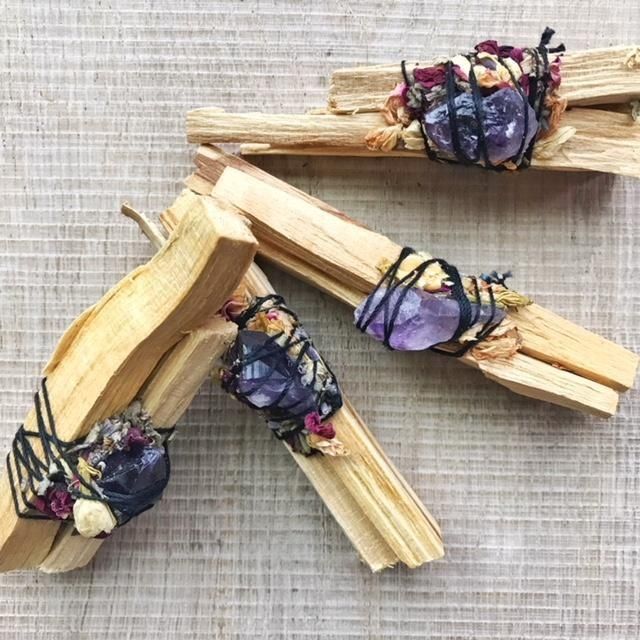Is the palo santo in danger of extinction?
Palo Santo sticks are burned for spiritual ceremonies, such as the ritual of purification with smoke, which has different purposes but is generally said to ward off bad energies.

Palo santo - the aromatic wood that has been used for centuries for traditional healing practices and in spiritual ceremonies of indigenous and mestizo cultures in Latin America - has become very popular in the commercial arena, and concerns have been raised about its conservation status.
Its popularity within the personal care industry is due to its warm aroma when burned as incense and its indirect promises to cleanse a space of "bad energy". Memes abound that portray the palo santo as being just a couple of incense sticks away from extinction. Some claim that only 250 trees remain. The reality is not so bad, but it is certainly complicated.
What exactly is palo santo?
The tree species used in the welfare industry is called Bursera graveolens, and it grows throughout the American continent, specifically in Mexico, Peru, Costa Rica, Guatemala, Honduras, the Galapagos Islands, and extensively in continental Ecuador. In order for Palo Santo to have the best quality, the wood must be harvested with a particular method. Its age of maturity is from 50 to 70 years, which in relative terms is not much.
Once the tree dies of natural causes, it must be left in place for at least five to eight years so that the oils of the heartwood mature sufficiently and quality incense can be made. That old wood that has fallen down is then processed into incense sticks. Be on the lookout for synthetic palo santo, in which chemicals are used to produce the characteristic aroma of palo santo. It is knot known how many are in circulation, but be sure to read the small print on the package. It will usually say "synthetic."
Is palo santo endangered?
Palo Santo is not endangered. The International Union for Conservation of Nature (IUCN) published for the first time a review of the conservation status of Bursera graveolens and declared it of lesser concern.
So where did the confusion come from?
This is due to several factors. First, a case of mistaken identity. An entirely different species, Bulnesia sarmientoi, is also commonly known as "palo santo" and grows in the Gran Chaco region of South America. It is dark wood, similar to mahogany, which is used for its essential oils in the manufacture of products such as furniture. This tree is indeed in danger of extinction, and people may mistake it for Bursera graveolens when they research it online.
There is also the question of the region compared to the international conservation status. The IUCN, which declared Bursera graveolens to be of lesser concern, takes into account the global populations of a species when making its assessment. However, national governments determine the regional conservation status of a plant, i.e. a plant may be listed as an endangered species in one country and not in another. Rumors circulating online may date back to 2005 when Peru classified the palo santo in its region as an endangered species.
What is palo santo for?
Palo Santo has a sweet but complex aroma. Its essential oil is used for its fragrance in consumer products such as shampoo, perfume, and soap. Palo Santo sticks are burned because they are considered a sacred tool for spiritual ceremonies such as the ritual smoke purification, which has different purposes but is generally said to ward off bad energies. These practices originated in indigenous cultures, but palo santo is also used in Catholic religious ceremonies in Latin America.
So can I go back to using palo santo as before?
Not without some reflection. Although palo santo is not endangered, its habitat, the tropical dry forest, is. The tropical dry forest has been decimated. Only 5 to 10 percent of the world's tropical dry forests are estimated to be intact. Because tropical dry forests have a dry period (unlike rainforests), they are suitable for human activity. People can come and cut down the trees in order to use the land for something else, like raising cattle.
The most abundant populations of palo santo are found in Ecuador, but there are small populations in other regions. If you don't know where the palo santo you're using comes from, it might come from one of these small populations where improper extraction could wipe out that specific, regional group of palo santo.
Buying palo santo certainly has the potential to endanger the species and people could be participating in the annihilation of rare populations of palo santo. To further complicate matters, what we know as Bursera graveolens may actually be several species.
The isolated populations found throughout Central America and the Galapagos may be subspecies or even a different species that is so limited that it could not be adequately extracted. All of this means that consumers must ensure that the palo santo they are buying is produced in a sustainable and ethical manner.




